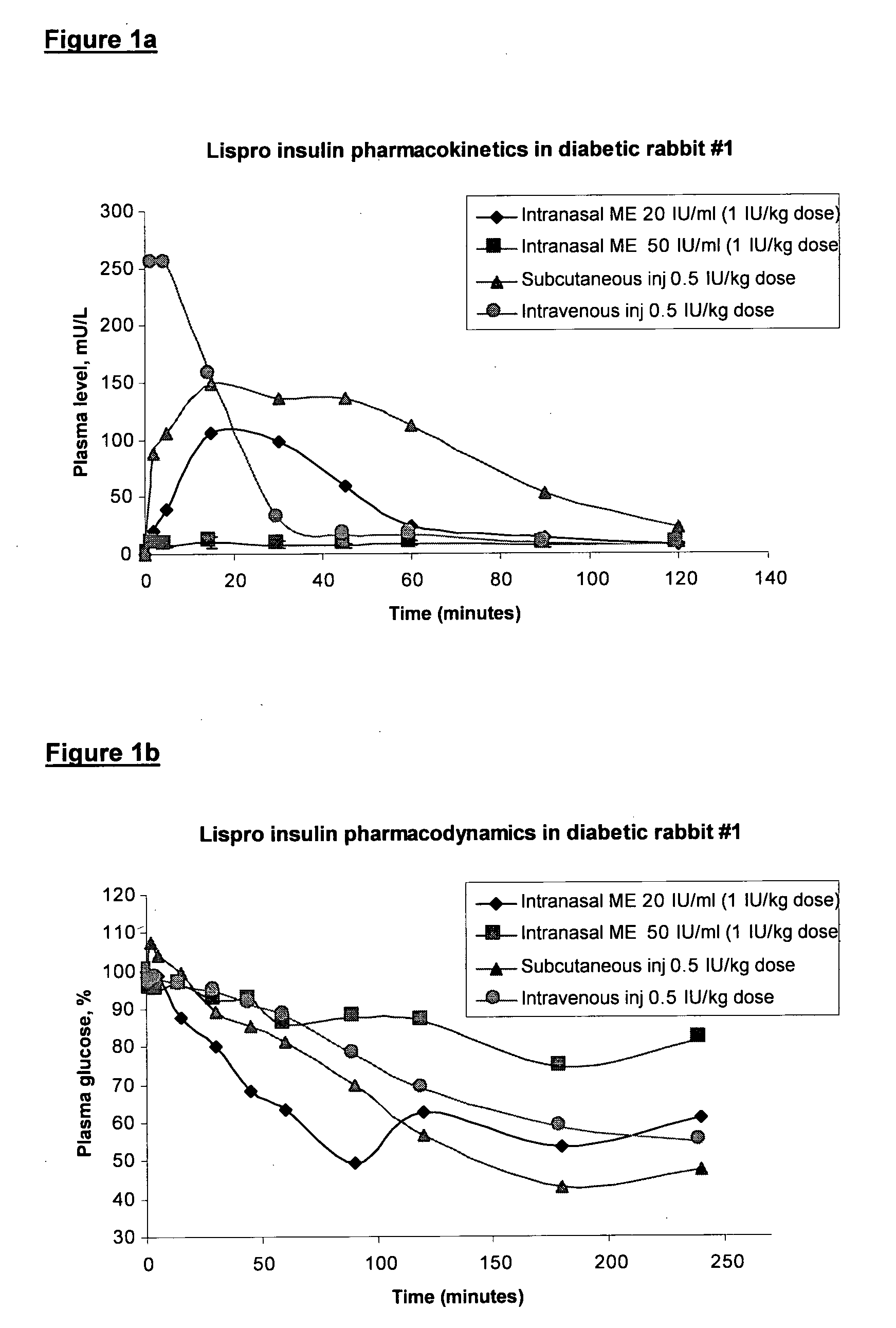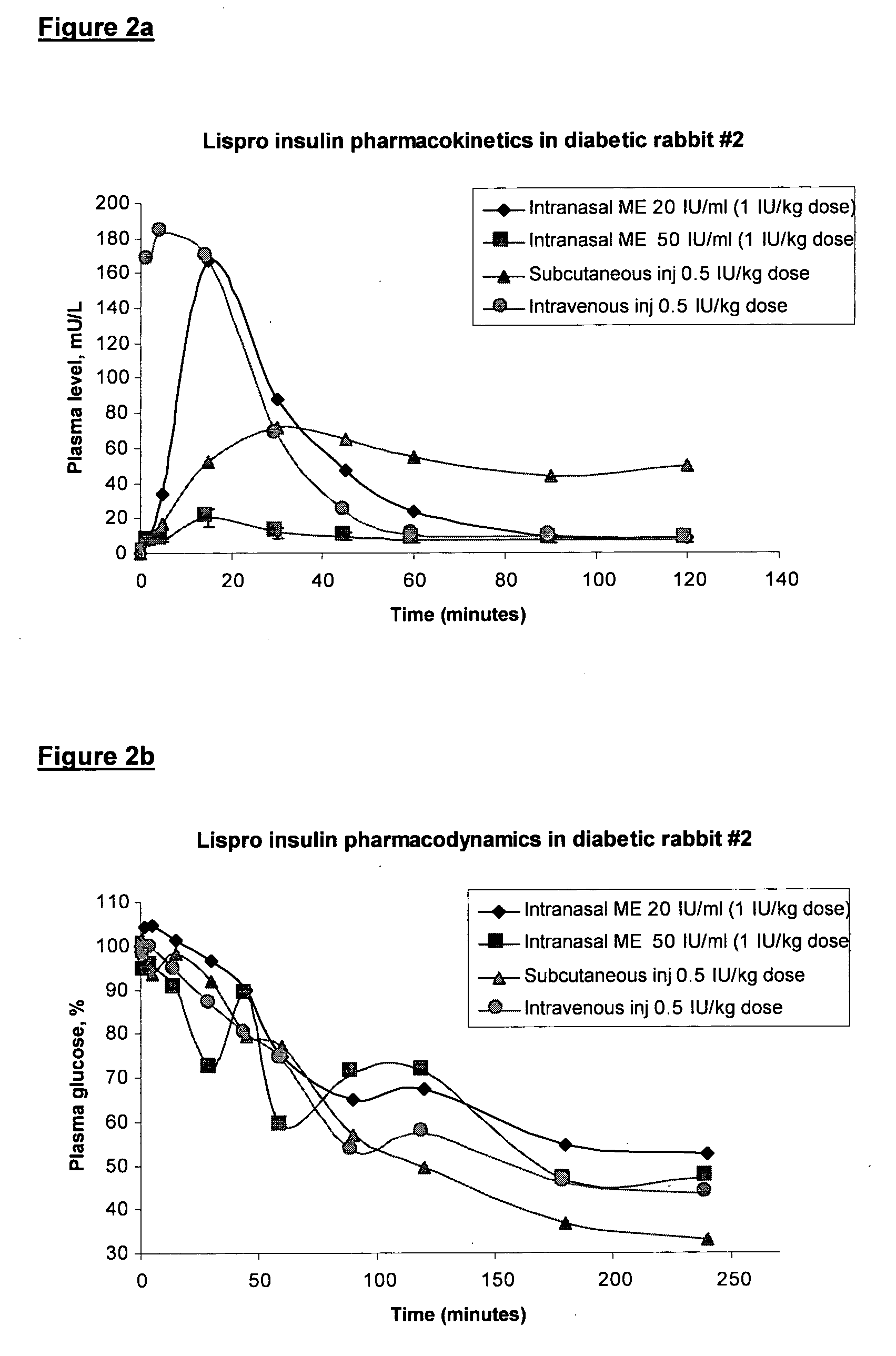Pharmaceutical compositions based on a microemulsion
a technology of microemulsions and pharmaceutical compositions, applied in the direction of hormone peptides, peptides/protein ingredients, peptides, etc., can solve the problems of partial loss of some drugs, ineffectiveness, and discomfort of patients, and achieve the effect of increasing drug penetration/absorption
- Summary
- Abstract
- Description
- Claims
- Application Information
AI Technical Summary
Benefits of technology
Problems solved by technology
Method used
Image
Examples
example 1
Preparation of Micro-Emulsions
[0139]Micro-emulsions, having compositions as exemplified, but not limited to the examples in the tables hereinbelow, were prepared for example by the following methods:
1. Liquid Microemulsion
[0140]a) A required amount of a water-soluble drug is dissolved in 20 g water containing 0.1% benzyl alcohol (preservative). In a separate vessel 10 g isopropyl palmitate (or myristate), 14.6 g glyceryl oleate, 11.67 g propylene carbonate, and Labrasol are mixed well. Then the aqueous solution is added and mixed by a magnetic stirrer or an electrical mixer (e.g., Heidolph mixer). The micro-emulsion is stored at 4° C. or room temperature for further use[0141]b) 20 g water containing 0.1% benzyl alcohol or benzoic acid is mixed with 10 g isopropyl palmitate (or myristate), 14.6 g glyceryl oleate, 11.67 g propylene carbonate, and Labrasol. Then, the drug is added and mixed by a magnetic stirrer or an electrical mixer (e.g., Heidolph mixer) until completely dissolved. ...
example 2
Solid Microemulsion Preparation for the Purpose of Dermal or Transdermal Patch
[0143]a) In a 200-ml vessel, 10 g of isopropyl palmitate (or myristate), 14.05 g glyceryl oleate, 11.25 g propylene carbonate, 42.2 g Sisterna PS750, and 19.5 or 15 g water were mixed together using a high speed stirrer such as a Heidolph mixer at a low speed for 5 minutes. A drug (e.g. 3 or 7.5 g lidocaine base) was added and dissolved in the microemulsion for 15 minutes at the same speed. After complete dissolution, 50 g of Jaguar C162 were added and mixed for 30 more minutes at a low speed. The gelled micro-emulsion was stored in special circle-shaped molds at room temperature to form a patch.[0144]b) In a 200-ml vessel, 10 g of isopropyl palmitate (or myristate), 7.8 g glyceryl oleate, 6.25 g propylene carbonate, 23.45 g Labrasol, and 49.5 or 45 g water were mixed together using a high speed stirrer such as a Heidolph mixer at a low speed for 5 minutes. A drug (e.g. 3 or 7.5 g lidocaine base) was added...
example 3
Microemulsion Semi-Solid Preparation for Dermal or Nasal Gel
[0145]In a 200-ml vessel, 10 g of isopropyl palmitate (or myristate), 37.5 g glyceryl oleate, 25 g propylene carbonate, 12.5 g Labrasol, and 9 g water were mixed together using a high speed stirrer such as a Heidolph mixer at a low speed for 5 minutes. A drug (e.g. 5 g diazepam) was added and dissolved in the microemulsion for 30 minutes at the same speed. After complete dissolution, 1 g of carbopol 934 was added and mixed for 30 more minutes at a low speed. The micro-emulsion gel was stored in jars or tubes for further use.
PUM
| Property | Measurement | Unit |
|---|---|---|
| molecular weight | aaaaa | aaaaa |
| temperature | aaaaa | aaaaa |
| wash-out time | aaaaa | aaaaa |
Abstract
Description
Claims
Application Information
 Login to View More
Login to View More - R&D
- Intellectual Property
- Life Sciences
- Materials
- Tech Scout
- Unparalleled Data Quality
- Higher Quality Content
- 60% Fewer Hallucinations
Browse by: Latest US Patents, China's latest patents, Technical Efficacy Thesaurus, Application Domain, Technology Topic, Popular Technical Reports.
© 2025 PatSnap. All rights reserved.Legal|Privacy policy|Modern Slavery Act Transparency Statement|Sitemap|About US| Contact US: help@patsnap.com



